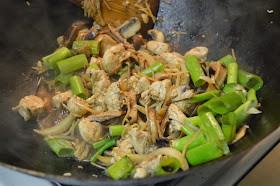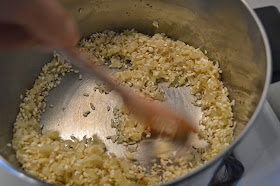The only time in my life that I tried preserved lemons was in an iced fermented lemon drink at a Vietnamese restaurant, and it was one of the worst experiences of my life. So when I saw this, I thought: let's spend a month making these and eat them again! Well, when you go to the culture that invented the stuff, it turns out they are used in much more pleasant ways, such as this delicious chicken tagine.
Tagines, known by their namesake ceramic or cast iron conic cooking devices famous in Moroccan culture, are nothing more than a stew of protein and vegetables or fruit, often featuring goat, lamb, or kid, but in some cases using chicken, or even chickpeas. This one features preserved lemon, which is an interesting way of keeping lemons for long periods that involves packing them in salt. The flavor is extra tart, slightly sour from the fermentation, and only good in small doses. But man, do they add an interesting flavor to complex sauces like what is created in this dish.
We modified the recipe ordering slightly to be more practical, and I may go back and revise this to use chicken quarters instead of a whole chicken, which we think would be faster and better. Regardless, this dish was well worth the effort, and had so much going on that we were completely floored by how unique it was. Highly recommended if you have some time to make preserved lemons on your own, which are actually very easy.
 |
| Preserved lemons are incredible in sauces, and not to be eaten out of the jar as a condiment |
Moroccan Chicken Tagine with Preserved Lemons and Olives
Modified from Morocco, by Jeff Koehler
- 3-4 cups cooked white long-grain rice
- 1 cup plain greek yogurt
- 3 tbsp milk
- Salt
- 1 tbsp finely chopped fresh mint or 1 tsp dried
- 4.25 lb chicken
- 1 preserved lemon
- 2 garlic cloves, minced
- 3 tbsp finely chopped flat-leaf parsley
- 3 tbsp finely chopped cilantro
- 1 tsp ground ginger
- ½ tsp turmeric
- Generous pinch saffron threads, dry-toasted and ground
- Salt and freshly ground white pepper
- 2 tbsp olive oil
- 2 tbsp fresh lemon juice
- 2 medium red onions, finely chopped
- 1 tbsp butter or smen
- 1 cup green olives, pitted
 |
| Scrape the pulp out and preserve the peel for making garnishelater |
Quarter the preserved lemon lengthwise, rinse, and remove
the seeds. Without breaking the ppel,
scrape away the pulp with a spoon, reserving the peel. Finely chop the pulp. In a small mixing bowl, add the lemon pulp
and any juices, garlic, parsley, cilantro, ginger, turmeric, saffron, salt and
white pepper, olive oil, lemon juice, and 2 tbsp water. Blend well.
Clip off the chicken wing tips and the tail, and trim any
excess fat. Rinse the chicken and pat
dry with paper towels. In a large pot
that will comfortably hold the chicken, create a bed of the red onions. Set the chicken breast-side up on top of the
onions and rub with the saffron mixture, pushing some of the mix under the skin
without tearing it. Add butter to the
onions and pour 1 cup of water down the sides of the pot, avoiding the chicken. Cover and cook over medium heat for 20
minutes.
Turn the chicken breast-side down, cover, and reduce heat to
low, and cook for another 20 minutes.
Then add 1 more cup water, loosely cover, and simmer until chicken is
very tender, about 50 minutes. Stir in
water as necessary to keep sauce from drying.
While chicken cooks, preheat oven to 350 F. Prepare the yogurt sauce by whisking together
yogurt, milk, a pinch of salt, and the mint in a small bowl. Cover and refrigerate until ready to serve. Trim preserved lemon peel segments into cool
shapes.
After chicken is tender, remove to a plate for a few
minutes, pouring juices back into pot / tagine.
Rub chicken with remaining ½ tbsp. butter, place on a baking sheet, and
bake in oven for 10 minutes, until crispy.
At same time, heat pot to high, add olives, and cook sauce uncovered
until thickened slightly.
Transfer chicken to serving dish and lay cut lemon peel
pieces on breast. Spoon sauce and olives
around chicken. Serve with rice in one
bowl and yogurt sauce in another on the side.





















